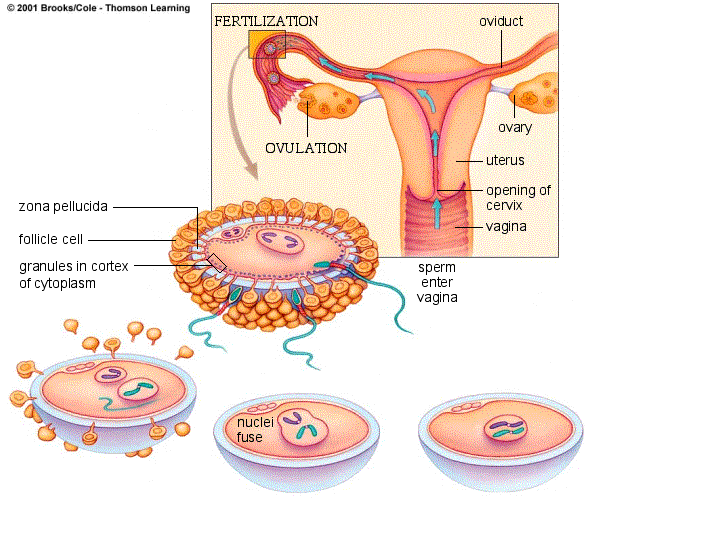

If sperm are present in the oviduct at the time of ovulation, fertilization takes place in the oviduct. Zygotes form as a result of fertilization. In fertilization, the egg nucleus (containing the haploid number, or n chromosomes) unites with the sperm nucleus (containing n chromosomes). This union produces a zygote of the original diploid or 2n chromosome number. In this way, the normal (2n) somatic number of chromosomes is restored, and homologous pairs are formed. The rest of development consists of mitotic divisions. When the egg and the sperm join, they trigger a cascade of events that occur as the zygote begins to divide rapidly.
This animation (Audio - Important) describes fertilization.
Cleavage of the embryo starts in the oviduct. The developing embryo travels down the oviduct, and, within five to ten days, implants itself in the uterine wall. Initially, the fertilized embryo divides into many undifferentiated cells.
In the earliest stages, mitotic divisions result in one cell producing two cells, which produce four cells, which produce eight cells, and so on. This ultimately creates what is known as a morula, or a solid ball of cells. The morula continues to divide and form the blastula, which is a hollow ball of cells (a single layer thick) produced by the pressure of cells on one another. The central cavity is filled with fluid secreted by the cells, and is referred to as the blastocoel. More rapid division of cells at one end of the blastula causes an inpocketing or involution known as the two-layer gastrula. Two germ layers, ectoderm and endoderm, are initially present, endoderm on the inside and ectoderm on the exterior. In a three-layer gastrula, mesoderm cells develop between the ectoderm and endoderm. This formation and rearrangement of the three germ layers is known as gastrulation.
This animation (Audio - Important) describes gastrulation
This animation (Audio - Important) describes early cleavage of the embryo.
Differentiation of Embryonic or Germ Layers
In vertebrate embryos, cells become arranged to form three primary tissues that give rise to all adult tissues:
In the next stage of embryonic development, the cells of each germ layer begin to differentiate and specialize to form tissues, organs, and organ systems. Differentiation of cells occurs when the form and function of cells changes to reflect a distinct function or developmental fate. Ectoderm gives rise to skin and nervous system. The endoderm becomes the lining of digestive and respiratory tracts, parts of the liver and the pancreas, and the bladder lining. The mesoderm develops into the muscles, skeleton, circulatory system, excretory system (except bladder lining), gonads, and the inner layer of skin (dermis).